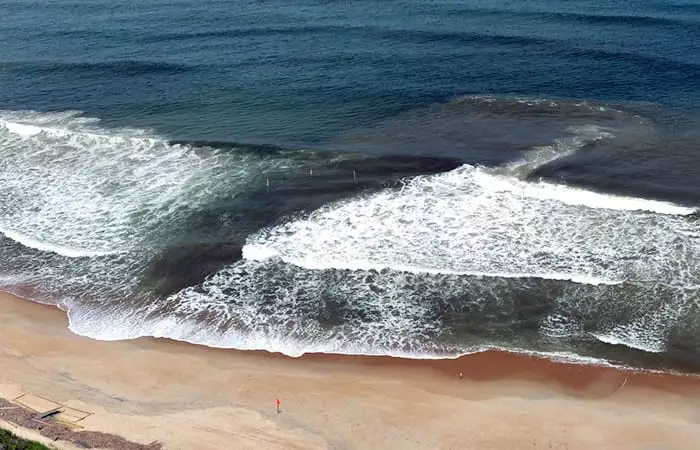Forecast alerts for rip currents will soon be given by Indian National Centre for Ocean Information Services (INCOIS) and the Indian Space Research Organisation (ISRO) under a new initiative.
- The focus is on enhancing beach safety through a coastal video surveillance system, providing crucial information on complex coastal and nearshore processes.
What are Rip currents?
- Rip currents are powerful, narrow channels of fast-moving water that flow from near the shore to the deeper ocean or sea.
- They are a natural and common coastal phenomenon, typically occurring at beaches with breaking waves.
- Rip currents can pose dangers to swimmers and are a leading cause of beach-related incidents.
- These are prevalent along the East, Gulf, and West coasts of the U.S., as well as along the shores of the Great Lakes.
Causes and Occurrence:
Wave Action:
- Rip currents often form when waves approach the shore at an angle.
- As waves break and water rushes towards the shore, it accumulates in the form of “run-up” or “wave setup.”
- This excess water then seeks a path of least resistance to flow back seaward, creating a concentrated and narrow current.
Sandbars and Underwater Features:
- The presence of sandbars, channels, and other underwater topographic features greatly influences the formation of rip currents.
- The water flowing onto the shore during wave action tends to follow the deeper channels, creating concentrated flow paths seaward.
- The breaks in sandbars can act as channels for the water to flow back out to sea, forming rip currents.
Tidal and Wind Effects:
- Tidal patterns and wind direction can also impact the development of rip currents.
- For example, during low tide, the presence of sandbars and deeper channels becomes more pronounced, increasing the likelihood of rip current formation.
- Wind can influence the strength and direction of the currents as well.
Characteristics:
- Formation: Rip currents form when waves break near the shore, causing water to accumulate near the coastline.
- This excess water then returns seaward in concentrated channels, creating a narrow, fast-flowing current.
- Appearance: While rip currents are not always easily visible, some signs include differences in water color, choppier and foamier water, or debris moving seaward.
- Strength and Speed: Rip currents can be very powerful, with speeds that can exceed 5 miles per hour (8 km/h).
- This is faster than most people can swim.
- Narrow and Focused: Rip currents are typically narrow, ranging from about 10 to 100 feet (3 to 30 meters) in width.
- They can extend from the shoreline beyond the breaking waves.
- Pulling Effect: The primary danger of rip currents is their ability to pull swimmers away from the shore and into deeper water.
Ref: Source
| UPSC IAS Preparation Resources | |
| Current Affairs Analysis | Topperspedia |
| GS Shots | Simply Explained |
| Daily Flash Cards | Daily Quiz |




